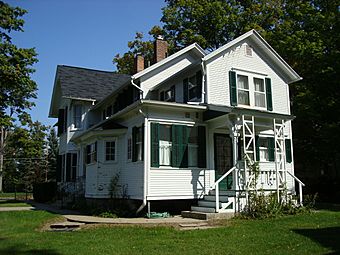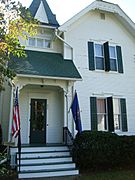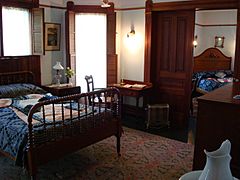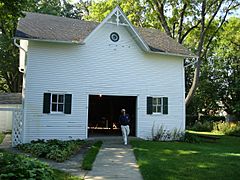Mann House (Concord, Michigan) facts for kids
|
Mann House
|
|

House in 2008
|
|
| Location | 205 Hanover Street, Concord, Michigan |
|---|---|
| Built | 1883 |
| Architectural style | Late Victorian |
| NRHP reference No. | 70000273 |
Quick facts for kids Significant dates |
|
| Added to NRHP | October 15, 1970 |
The Mann House is a special old home located at 205 Hanover Street in Concord, Michigan. It's recognized as a Michigan State Historic Site and is also on the National Register of Historic Places. Since 1970, this historic house has been open to the public as a museum.
Contents
History of the Mann House
Building the Family Home
Daniel Sears Mann and Ellen E. Keeler got married in 1873. They lived on a farm just outside of Concord. The couple had three children, but sadly, one of them passed away when they were young.
By the 1880s, the Mann family decided it would be better to live in town. This way, their daughters, Jessie Ellen and Mary Ida, could easily go to school in Concord. They bought some land and built this house between 1883 and 1884. As the girls grew up, their home became a popular place for social gatherings in the town.
The Mann Sisters' Lives
Jessie Ellen Mann graduated from the University of Michigan in 1906. After college, she became a math teacher, mostly working in schools in Battle Creek. She continued to live in the family home.
Around the early 1900s, Mary Ida went to the Philippine Islands to teach. There, she got married. She and her husband moved to different places across the United States. However, Mary Ida often came back to visit her childhood home in Concord. After her husband passed away in 1942, Mary Ida moved back into the Mann House for good.
Becoming a Museum
In 1947, a modern kitchen was added to the back of the house. The sisters, Mary Ida and Jessie Ellen, lived in the house until they passed away. Mary Ida died in 1959, and Jessie Ellen lived there until 1969.
In their wills, the sisters left the house to the people of Michigan. The Michigan Historical Center has been running it as a museum since 1970. The Mann House was officially named a Michigan State Historic Site on June 18, 1970. It was also added to the National Register of Historic Places on October 15, 1970. This house is a great example of what a middle-class home looked like in the 1880s.
Design and Architecture
Outside the House
The Mann House is mostly rectangular and built with a wooden frame. It was designed in the Late Victorian style. The outside walls are covered with clapboard siding.
Above the main entrance, at one corner, there is a tall, pointed tower. The roof has a cross-gable shape. You can see some fancy Eastlake Style decorations on the edges of the roof, the front door, the porch, and the small gables. Behind the main house, there is also a building that used to be a carriage house. The house has three entrances, each with its own porch.
Inside the House
When the house was first built, the first floor had an entrance hall, a parlor (a formal living room), a sitting room, a dining room, a bedroom, a kitchen, a pantry, and a wood-shed. Upstairs, on the second floor, there were five bedrooms.
When the kitchen was updated in 1947, the old wood-shed was changed into a laundry room. Today, most of the original furniture and household items are still inside the house. The ceilings are made of plaster, and there is a fireplace made of slate that looks like marble.
Gallery
See also




